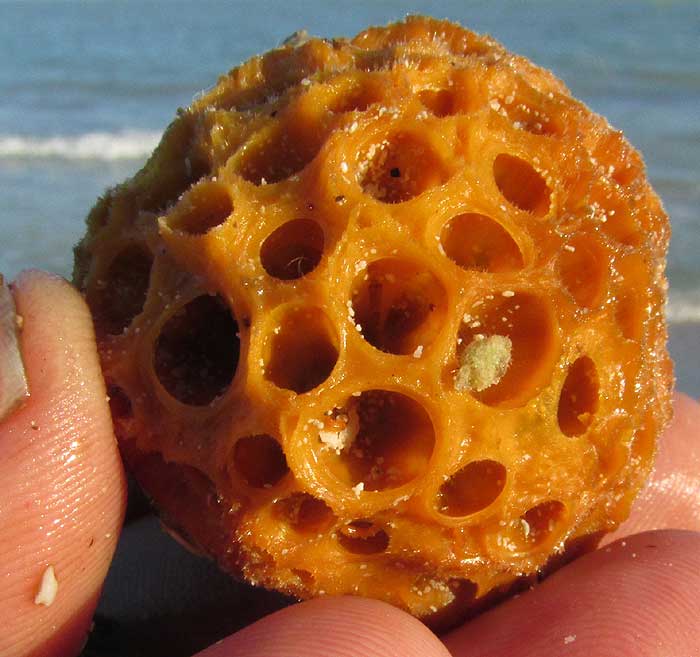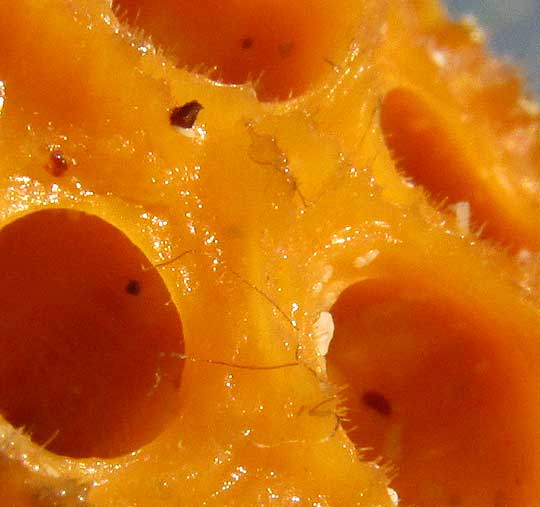Excerpts from Jim Conrad's
Naturalist Newsletter

from the December 14, 2014 Newsletter issued from Río Lagartos, on the Yucatan Peninsula's northern coast (~N21.60°, ~W88.16°), Yucatán state, MÉXICO
ORANGE BALL SPONGE
After several days of a stiff norte blowing from the north, one of many ocean gems washed onto the ocean-side beach of the slender finger of land forming Ría Lagartos Estuary's northern border was the orange, 1¼-inch broad (33mm), honeycombed sphere shown above. You can see that it's slightly hairy; a close-up of the surface better showing that appears below:

It was a sponge, but not as spongy as most, in fact rather firm. Volunteer identifier Bea in snowy, gray Ontario was only too happy to figure out that it was the descriptively named Orange Ball Sponge, sometimes called Mango Sponge, CINACHYRELLA ALLOCLADA.
At first I wasn't too sure about that name, because on the Internet most pictures of the sponge showed organisms covered with white to orangish fuzziness or, more commonly, they were generally fuzzy mottled with bald, orangish patches. Eventually it dawned on me that the fuzz had covered organisms that had been living and healthy when photographed, but on our washed-up one, the fuzz had been beat off.
The fuzz turned out to consist of tiny, needle-shaped "spicules." Spicules are diffused throughout a sponge's body to provide internal structure, and sometimes they cover a sponge's surface to offer defense against predators. The sharp, outward-pointing, hairlike spicules on our find were protective ones of the latter kind. Sponge spicules come in many forms, from our simple, needle-shaped ones, to cylindrical ones, to symmetrical and unsymmetrical forms composed of several slender needles, and their composition can be calcareous, siliceous or made of a collagen protein known as spongin. During serious sponge identification, spicule shape is of tremendous importance.
When holding an Orange Ball Sponge in the hand, the question arises of what kind of being this is. Is it animal, plant, or something else? Is it a colony of microscopic organisms, or a single living thing?
If our Orange Ball Sponge were a coral or bryozoan, it'd be a colony of tiny animals. Features suggesting that our sponge also is a colony and not just one animal include that it has no nervous, digestive or circulatory system, but rather must rely on a constant water flow through its body to obtain food and oxygen, and to remove wastes. Also, it lacks true tissues and organs, and displays no body symmetry.
However, despite this lack of features we think of as animals possessing, the Orange Ball Sponge as well as all other sponges are individual animals, albeit very simple ones. Animal traits they do have include that they are multicellular, heterotrophic (can't photosynthesize or otherwise manufacture their own carbon-based food), lack cell walls, and produce sperm cells.
Orange Ball Sponges often reach six inches across (15cm), so ours is a small one. They live in water 15-100 feet deep (5-30m), and normally occur in coral habitats, and on hard, often rocky, ocean floors.
In the US, Orange Ball Sponges occur on the Atlantic south of Cape Hatteras, North Carolina, all through the Gulf of Mexico and the Caribbean, and show up also on the coasts of Brazil and here and there in western Africa.